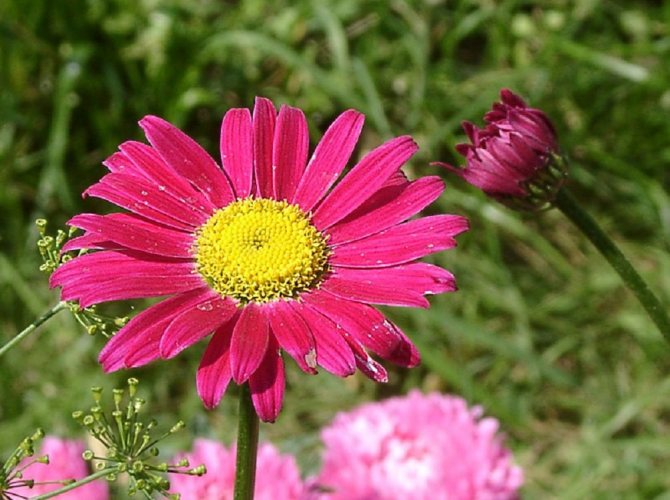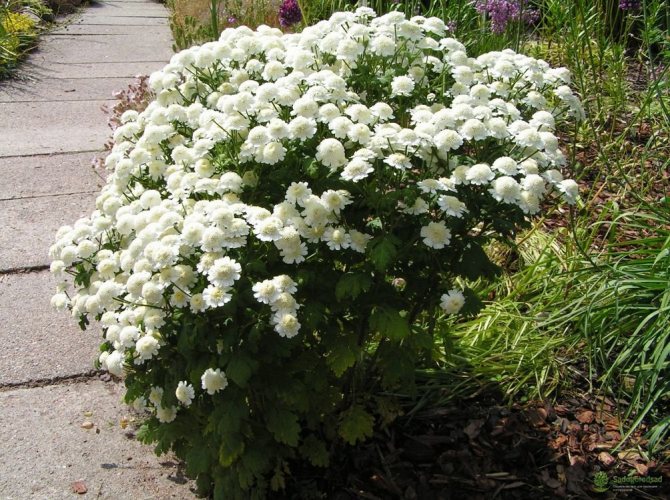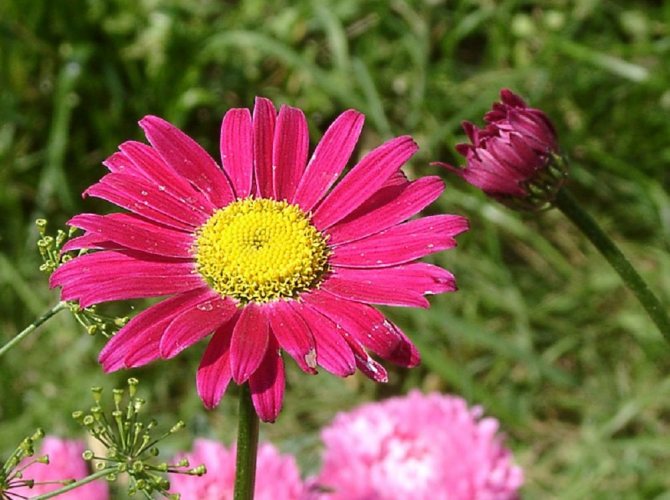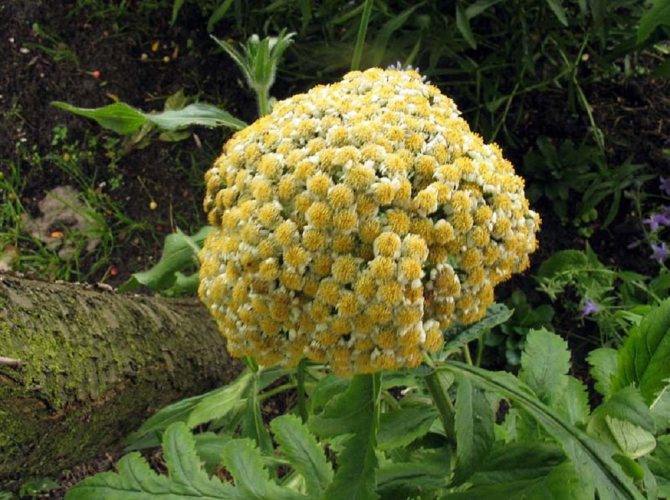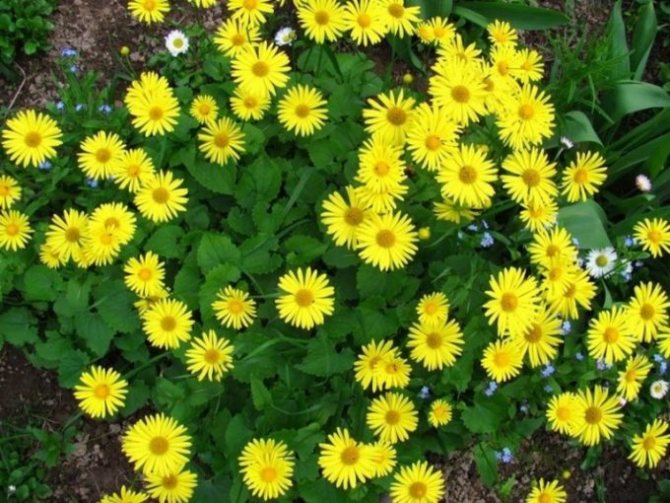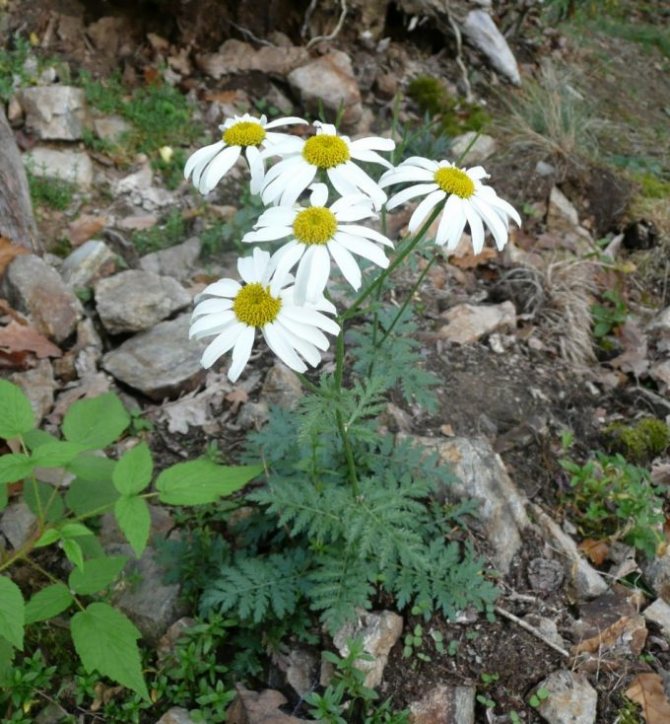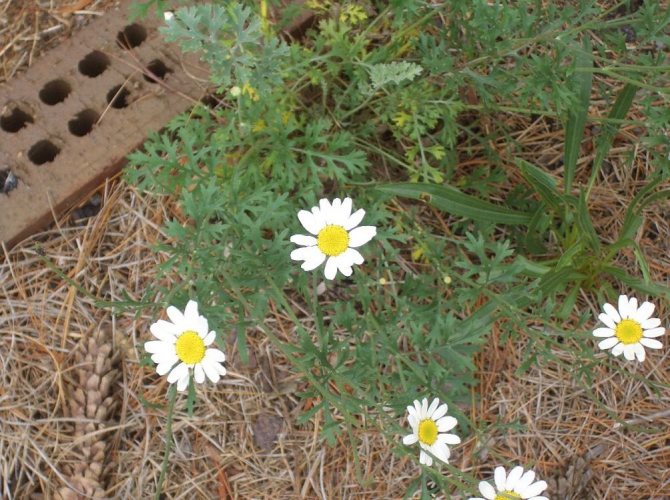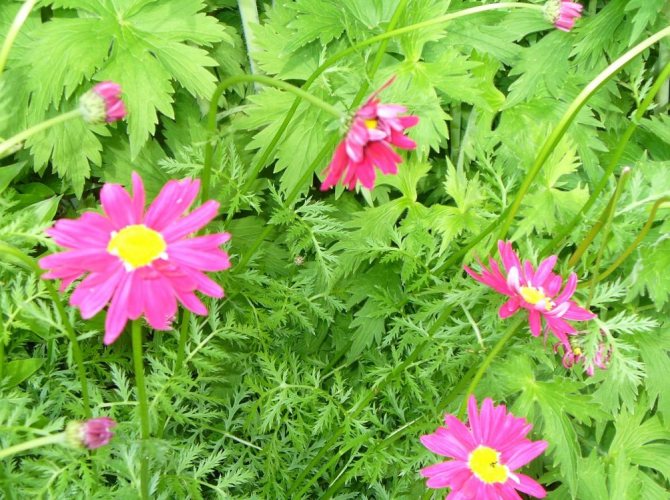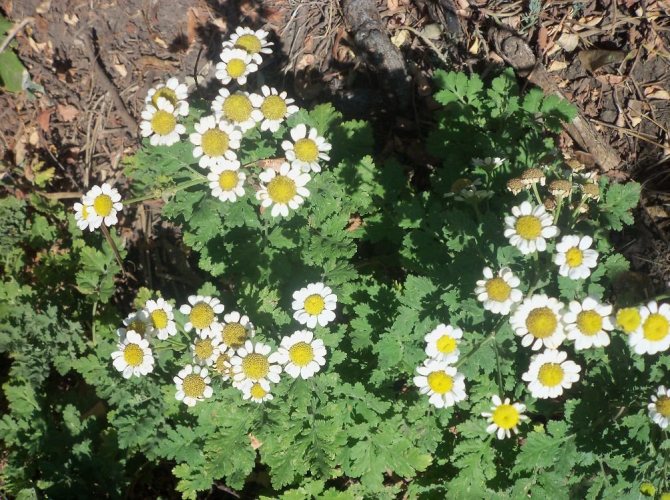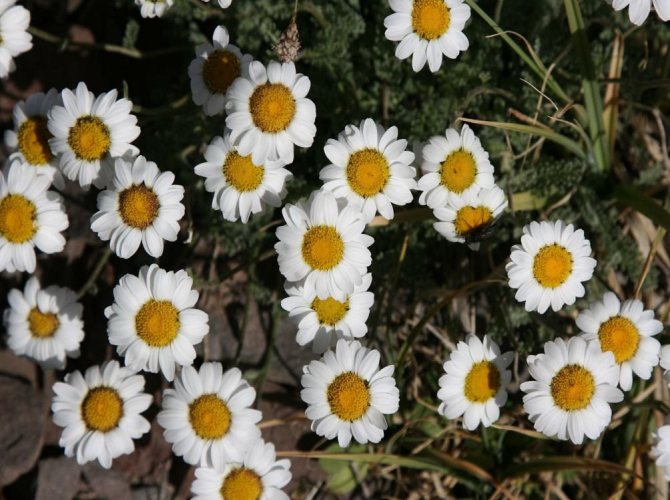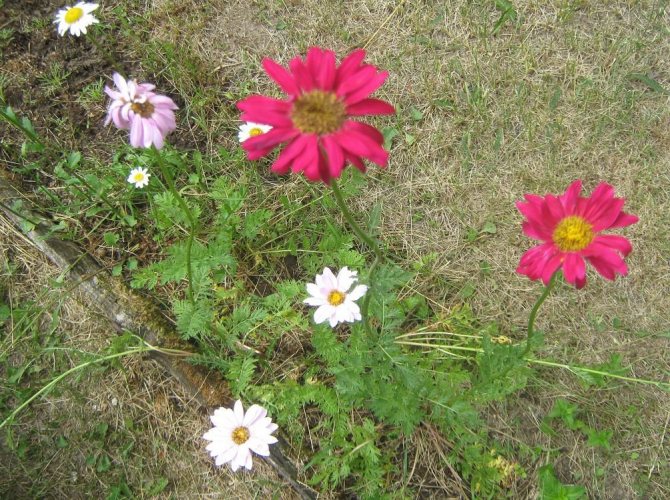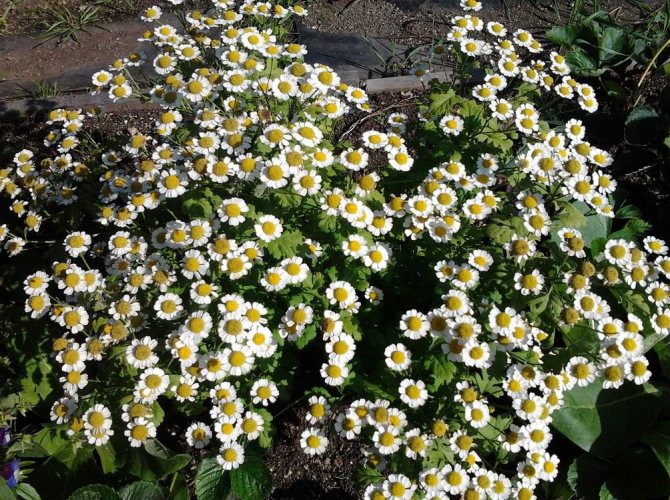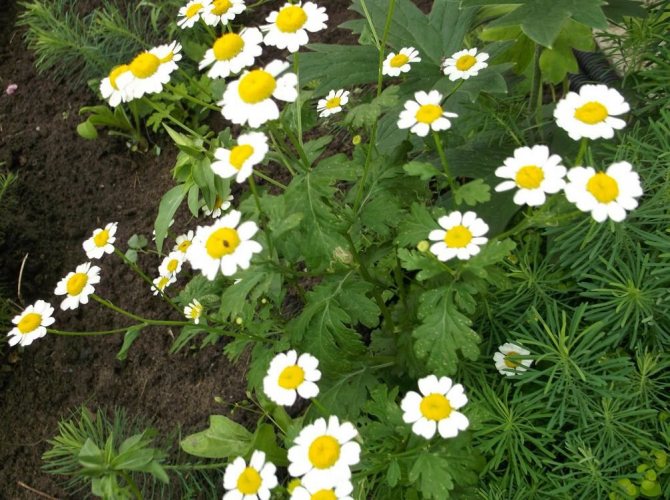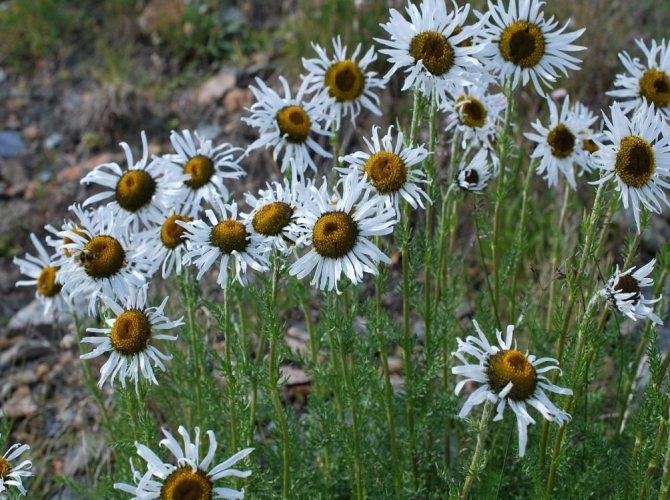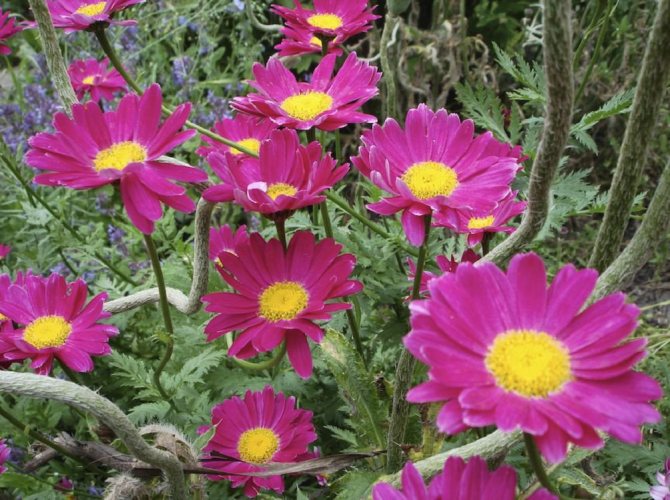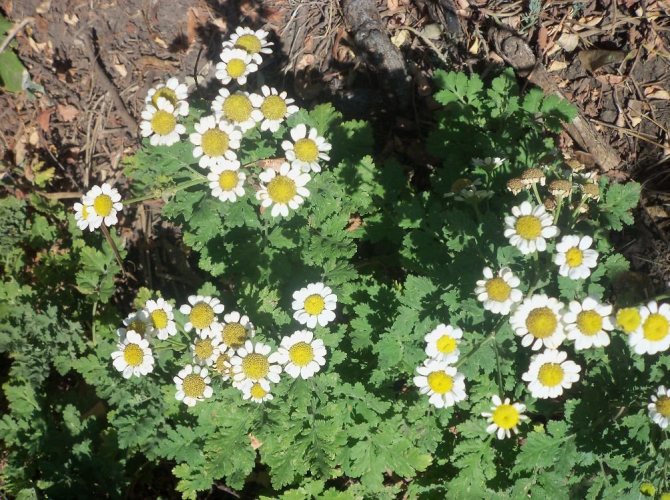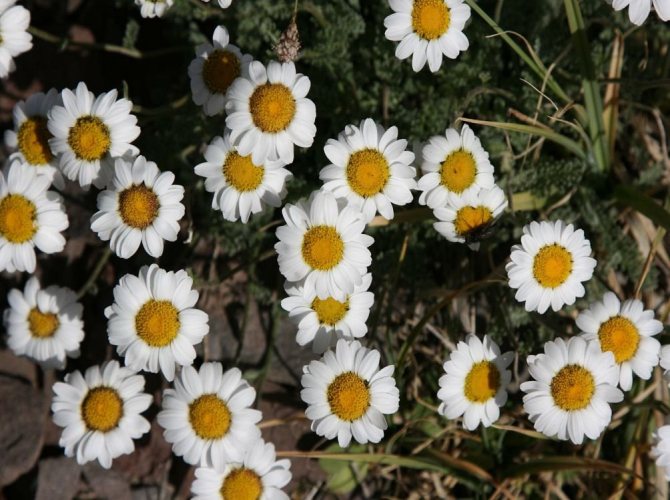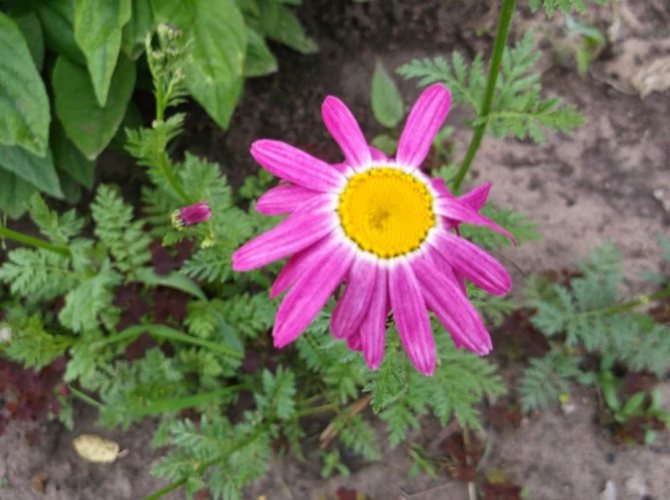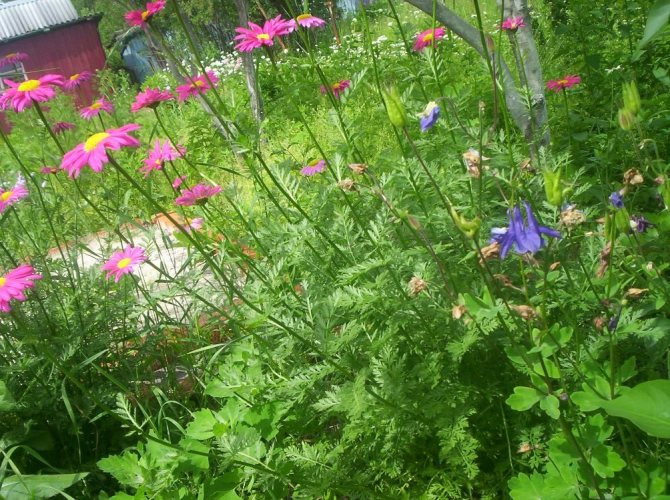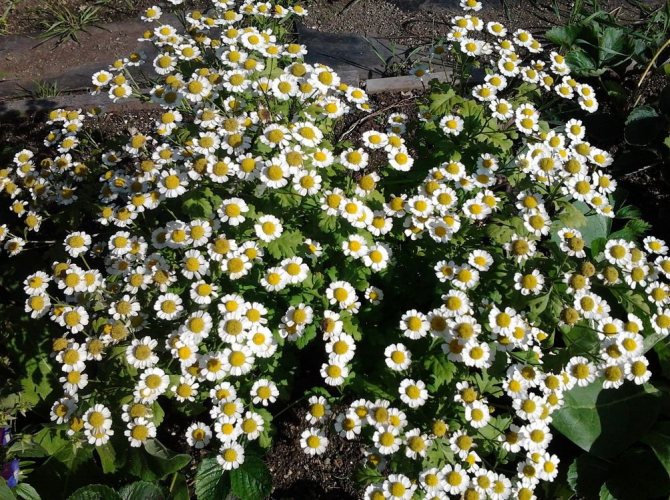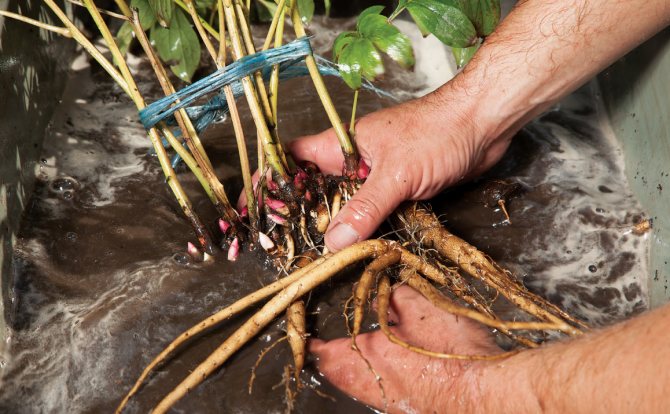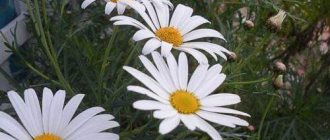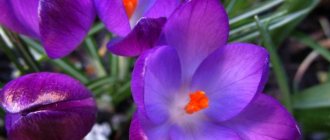Pyrethrum is a perennial plant with herbaceous shoots. It belongs to the Asteraceae family and grows in Eurasia and North America. This unpretentious plant will definitely appeal to lovers of chamomiles, since the flowers are very similar in shape to them. But at the same time they are distinguished by a lush core and bright shades of petals. In addition to its high decorative properties, pyrethrum is known for its ability to repel harmful insects such as fleas and bed bugs. Sometimes the plant can be found under the names "Dalmatian", "Persian" or "Caucasian chamomile", which reflects the area of growth of a particular species.
Types of pyrethrum: girlish, pink and others
The exact number of pyrethrum species has not been established, but there are several varieties that are suitable for home growing:
| View | Description | Flowers | Flowering period |
| Maiden | Perennial shrub from the southern regions of Europe. Branched, reaches 50 cm. The foliage is pale green, occasionally with tints of yellow. | Basket-shaped inflorescences, about 4 cm in diameter. They are common and double. White and yellow. | Early July - late August. |
| Pink | Perennial growing in the Caucasus. Grown as a biennial or annual. The stem is erect, with a height of up to 70 cm. It is one of the hybrid species. | Tubular or ligulate, bright yellow or pinkish in color. Buds up to 12 cm in diameter. | Mid June - end of July. |
| Shield | Perennial, homeland - the eastern regions of Europe, the Caucasus. The trunk is straight, reaching 1 m. The root foliage is about 40 cm long. | Inflorescences are corymbose, loose. Reed or tubular, yellow or white. | June July. |
| Large-leaved | A perennial plant that grows up to 1.5 m. | Small, formed into corymbose inflorescences. White, turning reddish by mid-summer. | End of May - mid-July. |

And thanks to the fruitful work of breeders, several varieties of pyrethrum were also discovered:
| Varieties | Description | Flowers | Flowering period |
| Comedian | A hybrid with an upright trunk about 80 cm high. | Reed and tubular, bright red or yellow. | From July to August. |
| Robinson's Giants | A variety of pink pyrethrum, one of the most popular varieties of this plant. The trunk is straight, with a height of about 80 cm. It is used for group planting, rabatok, as well as for cutting. | Reed. Color - pink or carmine. | Mid June - second half of July. |
| Golden ball | Derived from maiden feverfew, belongs to the decorative varieties. A perennial, but in Russia it is grown as an annual. Grows up to 25 cm. | Terry, have the shape of a ball. Bright yellow color. | June July. |
| Troubadour Tongue. | A kind of pink pyrethrum. Used to decorate flower beds. | Color - from white to red. | The next year after sowing (mid-June). |
| Scarlet star | Perennial plant up to 80 cm high. | Tubular (yellow) or reed (deep red). | Mid June - July. |
| Harmony | A variety of pink pyrethrum, with a 70 cm trunk. | Terry. The color is yellow or red. | Mid June - August. |


Botanical description
Feverfew has a fibrous root system and erect herbaceous shoots 50-70 cm high. The leaves are pinnately dissected in bright green color. Most of them are collected at the base in a dense rosette.Also, several leaves are alternately located on the stem, but they are smaller in size.
The top of each shoot is crowned with a large "basket" inflorescence with a diameter of 3-6 cm. It has long petals and a lush core, consisting of reed and tubular flowers. Reed flowers are concentrated at the edge, often they are pinkish in color. Yellow tubular flowers are found in the very center of the inflorescence. Smooth linear petals can be colored white, yellow, pink, crimson or lilac. Pyrethrum blooms in June-July. Longer flowering can be achieved by cutting.
After pollination, the fruits ripen - light brown achenes. They have up to ten ribs and a lobed or serrated crown. Long small seeds remain viable for 3 years.
Growing pyrethrum from seeds
Persian or Dalmatian chamomile (another name for pyrethrum) is effectively propagated by the seed method. But with such a dilution, the color of the buds can turn out to be unpredictable.
You can grow feverfew using seeds in the following ways:
- planting seedlings;
- direct landing in open land.
When using seedlings, the seeds are sown in early spring, then in May the seedlings are already placed on the final growing site. Since this planting material is quite small, professionals advise mixing it with sand and then sprinkling it with soil a little. Seedling pots are covered with foil to create a greenhouse effect. Seedlings emerge in a week.
After the appearance of 3 true leaves, the seedlings are transplanted into separate pots. During the month, they provide a temperature of +20 ° C.
Seeds are planted in open ground in May-June. When seedlings arise, the seedlings are placed in such a way that the gap between them is about 20 cm.
Persian chamomile planting
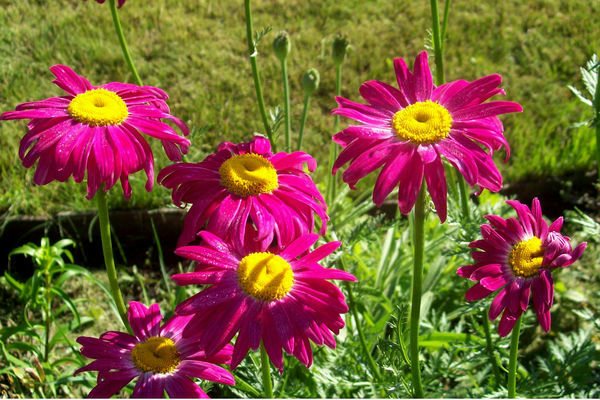

How to grow a plant by seed.
With self-collection of seeds, the safety of maternal characteristics will be at zero. Therefore, if you need the flowers to have signs of a certain variety or be painted in a certain color, then purchase the seeds in a specialized store.
Pyrethrum seeds are very small in size, for this reason, to facilitate sowing, they are combined with sand. Grains are sown at the beginning of the first spring month, and they are buried into the ground by thirty to fifty cm. You can plant the grains more easily - distribute them over the soil surface layer, after which the seeds are sprinkled on top with earth. The plantings are sprayed. The container is covered with polyethylene or glass, and then it is removed into a room with good illumination and a warm temperature regime (eighteen to twenty degrees). After the first shoots appear, the covering material is removed. Plants dive in separate containers after the development of 2 true leaves. Before transplanting into open conditions, the flower is hardened for fifteen days.
The plant is also cultivated without seedlings, but only in the south. The seeds are sown in open conditions at the beginning of the first autumn month.
Landing in the garden.
A wild crop loves to grow in fertile soil. Therefore, when cultivating in the garden, it needs a loose, nutrient-rich soil, and it must allow air to pass through. Cultivation of this plant on depleted, dry soils or sandstones is prohibited, and it also cannot be planted in a lowland where liquid stagnates, since the flower does not respond well to long-term excessive moisture, especially in cold weather. The optimal place for planting is lit by the sun's rays only 3-4 hours a day, most of the day is spent in the shade of a flower.
When planting, there should be an interval of twenty-five to thirty cm between pyrethrum.Planted plants need to be watered abundantly, and in the first ten days after planting they must be shaded from the direct sun. Perennial flowers begin to bloom next season after planting.
Planting feverfew
Sowing seeds or seedlings in the ground is recommended in late spring or early summer, when the threat of frost disappears.
They prefer well-lit areas, although Persian chamomile feels comfortable in partial shade. With a lack of light, the trunks stretch out, thereby reducing the abundance and duration of flowering.
The flower is undemanding to the soil, but it is recommended to opt for permeable soil, because the Dalmatian chamomile does not tolerate stagnant water. In acidic soil, add ash or lime.
Feverfew from bedbugs and fleas
A few centuries ago, the property of feverfew was known to rid the house of unpleasant parasites. The fact is that the alkaloid pyrethrin in its composition causes nervous paralysis in insects. Since ancient times, hostesses have collected Persian chamomile flowers, dried them and ground them into powder. It was added to baths for bathing, and also decoctions were made with which they sprayed linen, clothes and animal hair.
It must be remembered that in the light, useful substances quickly disintegrate and the effectiveness decreases, so you need to store the powder in a dark place. Spraying objects should be repeated every 1-2 days.
Reproduction of pyrethrum
In addition to planting seeds, the plant is propagated by dividing the shrub and cuttings.
The first option for breeding pyrethrum is performed every 3-4 years, by this period the flower is actively growing its lateral processes. For this, the shrub is removed from the soil, excess soil is removed from it. Division is performed manually. The resulting parts must be large, they are placed in the holes and watered abundantly.


Cuttings are obtained from young basal shoots, from late spring to August. Then it is transported to the nutritious and airy soil for rooting, the container is placed in partial shade. The earth is constantly moistened, and to reduce evaporation, the processes are covered with a film. Aerate and irrigate daily. Rooting takes place from 14 to 21 days. Then they carry out a transplant to the garden.
Plant care
Even busy or lazy gardeners can plant feverfew in their yard, since the plant needs minimal care. For its planting, well-lit sunny places are chosen. You can plant feverfew in partial shade, in which case the shoots will stretch out a little more. The soil for planting can be almost any. Only heavy, swampy soils are poorly tolerated by feverfew. On fertile garden soil, plants will look an order of magnitude larger. In too acidic soil, it is recommended to add a small amount of ash.


Pyrethrum are drought tolerant plants. They need to be watered only in prolonged intense heat, when the leaves begin to lose turgor, and the soil cracks. Watering is more important during the flowering period. The rest of the time, the plants are completely dispensed with natural precipitation. Immediately after planting, the soil can be mulched with peat or chopped grass. In this case, after watering, a dense crust will not form, and the weeds will also cease to bother.
Top dressing is carried out 2-3 times per season. Plants respond very well to the introduction of mullein. The first fertilization is carried out in the spring, before flowering. Immediately after the wilting of the inflorescences, a complex mineral composition is introduced. At the end of summer, you can water the bushes with an infusion of chopped weeds.
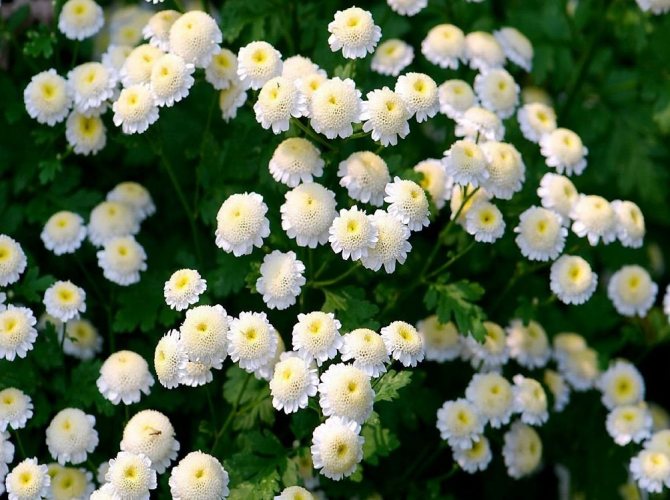

Withered inflorescences need to be cut off. This will prevent self-seeding, and will also allow the plant to accumulate strength and repeat flowering in 1-2 months. Taller varieties in open, wind-blown areas may need a garter.
You cannot grow flowers in one place for a long time, since overgrown bushes with their roots interfere with each other and impoverish the soil.Every 3-4 years they are divided and transplanted to a new place.
Feverfews are resistant to plant diseases and most parasites. Their juicy greens attracted the slugs. You can get rid of pests with the help of an impassable barrier made of ash or crushed eggshells. Some gardeners place planks next to the bushes, under which slugs hide in the summer heat and from where they are easy to get and destroy.
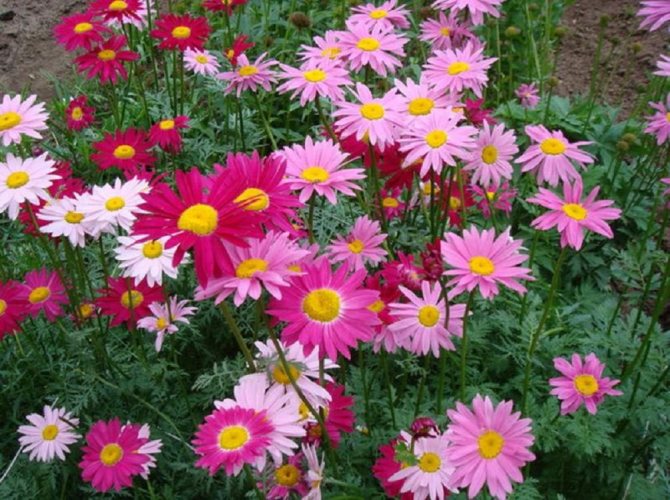

Diseases and pests of pyrethrum
As feverfew grows, it is attacked by insects and diseases:
| Symptoms (effects on foliage) | Disease / pest | Remedies |
| Fluffy gray coating, deformation of the trunk. | Fusarium. | Affected flowers are removed from the ground and burned. The area where the plant was grown is treated with any fungicide. |
| Holes. | Slugs. | Gather by hand. Correct the irrigation regime, preventing water stagnation. |
| Wilting, white spot. | Thrips. | The plant is removed from the ground and thrown away, the soil is sprayed with a systemic fungicide. |
| Yellowing. | Aphid. | With a strong lesion, feverfew is removed from the soil and removed from the site. With a small number of pests, the shrub is treated with Insecticides (Actellik, Aktara or Biotlin). Actions are repeated 2-3 times. |
Persian chamomile care
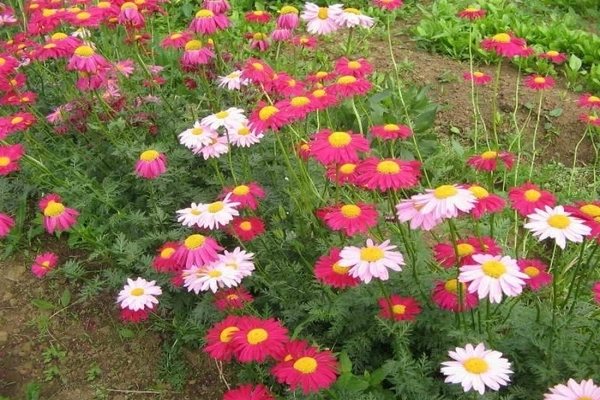

Caring for this flower is very easy. Such a perennial plant is suitable for those who cannot constantly care for garden vegetation. After strengthening the flowers after transplanting, they will not be afraid of weeds, as they are able to inhibit its growth. Therefore, weeding is required only in the first days of the growing season, and to reduce the frequency of weeding, the surface soil layer is mulched with organic matter. For good growth and development, the crop needs to be watered regularly. After watering, the surface soil layer is loosened to avoid the formation of a dense crust on it.
Feeding pyrethrum with organic substances and minerals. Do not overfeed the plant with nitrogen, otherwise, a quick green mass collection will occur, it will bloom poorly. There is a good reaction of the flower to the manure, which is quail.
The shoots are large, not so strong, because of this they will have to be tied up. After the plant has finished blooming for the first time, all peduncles are removed, you should not wait until the grains begin to form. Then, at the end of summer, the bush will begin to bloom again. Without transplanting in one area, the plant can be cultivated for four years, no more. During this time period, their strong growth will occur, so they will bloom poorly. For this reason, once every four years, the bushes are transplanted to a new site. Plants during transplantation, if necessary, need to be divided.
Diseases and harmful insects.
Persian chamomile has good immunity to various diseases and harmful insects. But rarely an illness can strike her. For example, a plant may at times be infected with fusarium or gray rot. Gray rot is a fungal disease, it damages plant fragments located above the soil surface, as a result, their surface is covered with a bloom of gray color, they are deformed, as a result of which the bush dies. Diseased pyrethrum is removed from the soil and destroyed, and the place of their growth is spilled with a solution of a fungicidal preparation. Also, Persian chamomile can get sick with fusarium, this is also a fungal infection. The penetration of its pathogens to the flower is carried out through the roots, and at first the vascular system is affected. The affected bush is not treated, so it is removed from the ground and destroyed in order to prevent the disease from spreading further. The soil and other bushes are treated with a fungicidal agent, which contains copper.
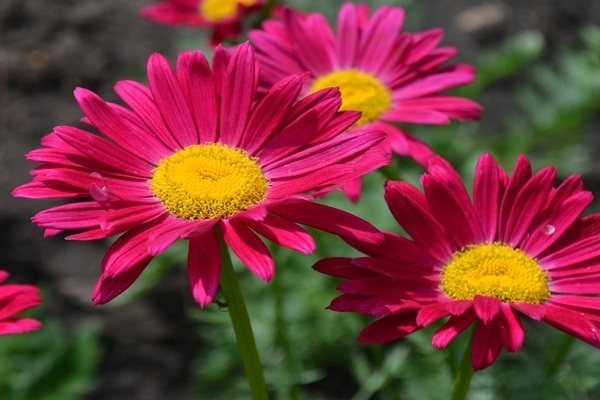

The flower can be attacked by thrips, slugs, aphids. Slugs love the leaves, so you will need to collect them by hand.To get rid of these pests as soon as possible, birds or hedgehogs are attracted to the territory. Thrips can often settle on the bush. There is no government on them, for this reason the plant is removed from the soil and destroyed, and the soil surface layer and the rest of the bushes are sprayed with insecticidal agents of systemic action. When settling on pyrethrum, aphids destroy it, but attempts can be made to treat, for this purpose, treatment with insecticidal preparations is carried out, it can be "Aktara", "Biotlin", "Aktellik". Usually, all the aphids are not destroyed the first time, for this reason, for the final disposal, it is necessary to carry out the treatment two or three times.
Feverfew after blooming.
After flowering culture in autumn, its aboveground part is cut to the level of the surface soil layer. Before the winter season, the surface soil layer is mulched with peat or covered with spruce branches. When hiding flowers for the winter season, they will not be afraid of frosty periods. After spring comes, the spruce branches are removed, the mulch layer is raked off, thanks to this, young shoots will quickly break through the thickness of the earth.
Mr. Dachnik advises: pyrethrum in landscape design
Used in carpet-type flower beds for edging. In this situation, the shrubs are trimmed to the required height and prevent bud formation.
They are also used for decorating borders. Bright colors enhance the appearance of the ridges and mixborders.


This shrub is considered the most optimal for decorating a country-style garden. This is explained by the fact that the flower looks great and takes root near ornamental plants.
The flower is used to decorate loggias and terraces. He also suits when drawing up bouquets.
Plant features
Among the types of pyrethrum, perennial plants predominate, but there are also annuals.
- Shoots are ribbed and slightly pubescent;
- The stem can reach a height of 1 meter;
- The plant has powerful roots, deeply they can penetrate about 3 meters;
- The leaf of the plant on one side has a gray-green tint, and on the other, ash-gray;
- The inflorescences are solitary and have a diameter of about 5 cm. The flowers of the plant are bisexual, bloom in May and bloom until the end of June;
- After flowering, a box with seeds is formed, which retain their germination for several more years.
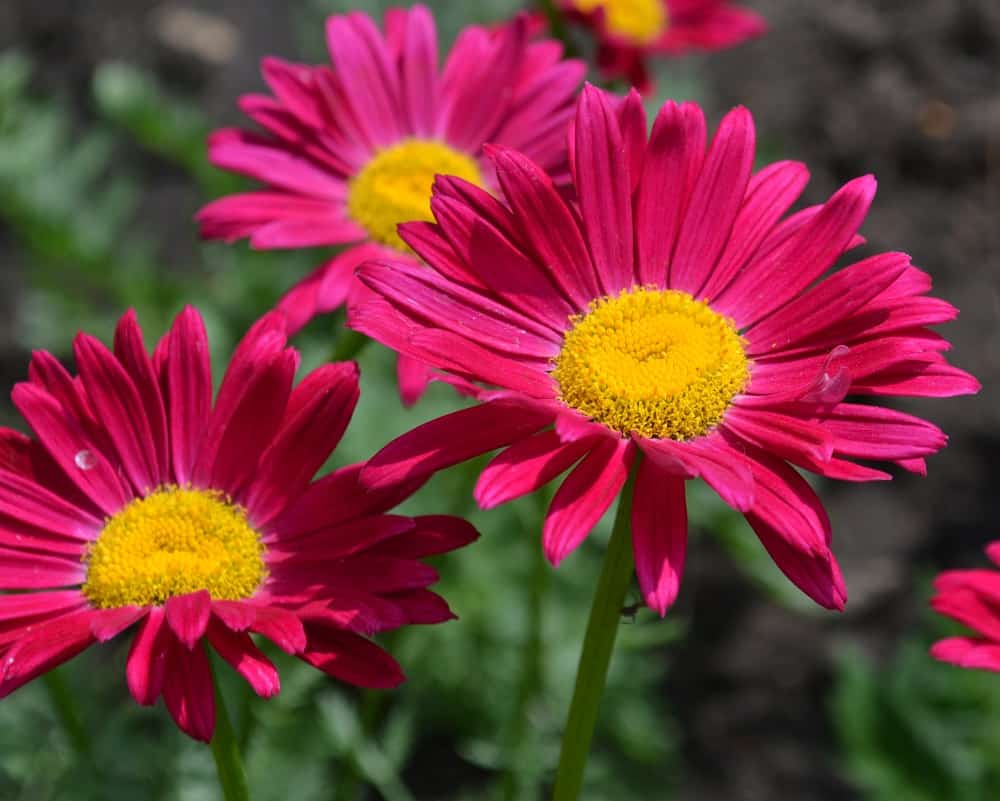

Useful properties of pyrethrum
In the old days, Dalmatian chamomile was used to lower the temperature, eliminate inflammation and pain in the head. This flower has been proven to have properties similar to aspirin.
In the 1980s, scientists pointed out feverfew as an effective agent in the fight against migraines. It was said that the powder of this plant relieves severe and frequent headaches much faster than expensive medicines. This was due to the fact that the flower contains parthenolide, which helps to block the synthesis of serotonin. And, as you know, the excessive content of this component in brain cells and blood vessels is recognized as the cause of the formation of migraine.
In addition, Dalmatian chamomile blocks the production of histamine, prevents the formation of blood clots in blood vessels, and has antimicrobial and anti-allergenic properties. From the foliage, they create applications against arthritis and rheumatism, are used to treat asthma and relieve pain during the menstrual cycle.
In combination with drugs, feverfew eliminates allergic manifestations of dermatitis and psoriasis.
This plant has an unusual appearance and medicinal properties, which attracts a large number of gardeners. Decoctions from this flower are often used to solder small children with allergies, accompanied by severe rashes.
Varieties
Florists cultivate few varieties of this plant. But it is necessary to take into account the fact that feverfew has many different varieties and types.
Pyrethrum "Beautiful" (Pyrethrum pulchrum, Tanacetum pulchrum).
This species of wild growing is found in the North China, Kazakhstan, Central Asian, North Mongolian and Siberian territories. Pyrethrum loves to grow in the tundra zone, on a placer and a slope of stones near the glacier. This perennial has a rhizome, it is also semi-rosette, it grows up to fifty cm, the surface is hairy. There are few shoots, they grow vertically, there are few leaves on them. The leaves growing at the roots are green in color, sit on elongated petioles, pinnate, cut into two lobes, may be bare or slightly pubescent. The leaves stretch up to fifteen cm, and are two cm wide. The leaves on the stem are sessile. Baskets can grow singly or form inflorescences in two or three baskets. Baskets consist of tubular-shaped flowers of gray color and reed-shaped flowers of white color.
Pyrethrum "Large-leaved" (Pyrethrum macrophyllum, Tanacetum macrophyllum).
This perennial comes from the Caucasian territory. Plants stretch up to one and a half meters. The inflorescence-scutellum in cross section is about ten cm, contains small white flowers. At the end of flowering, the color changes to red-brown. This variety is good to grow in a larger composition, it goes well with such vegetation as: rod-shaped millet, variegated miscanthus, sharp-flowered reed grass, and other decorative cereals.
Feverfew "Shytkovy" (Pyrethrum corymbosum, Chrysanthemum corymbosum, Tanacetum corymbosum).
Homeland - Caucasian, Eastern European territories, foothill Altai zone, grows on dry land. This rhizome perennial bears a din or two or three vertical shoots branching at the top, growing up to forty to one hundred and fifty cm. The leaves growing at the roots sit on elongated petioles, grow to thirty to forty cm. The leaves are pinnate, dissected into segments. The leaves on the stem resemble the leaves at the roots, but they are not so elongated, and the apical and median leaves are completely sessile, and those located below are sitting on the petioles. Inflorescence-scutellum is loose, contains fifteen to twenty baskets, which are located on elongated pedicels covered with hairs. The color of the achenes is gray, and the flowers of the reed type are white. The plant blooms in June days.
Pyrethrum cinerariifolium, or Dalmatian chamomile.
This herbaceous flower grows up to fifteen to forty-five cm. Leaves are silvery-gray in color, feathery, can be cut two or three times. The baskets have achenes of gray color and flowers along the edges of a light yellow or white color.
Pyrethrum "Red" (Pyrethrum coccineum, Chrysanthemum coccineum), or "Caucasian chamomile".
This plant can often be mistaken for feverfew "Pink". This species grows wild in the Caucasian territory. It has many different subspecies with reed-like flowers, which are painted in different colors from dark cherry to white. Quite often among them you can find subspecies that have terry baskets. The pyrethrum "Red" differs from the pyrethrum "Pink" by the presence of feathery, twice dissected leaves. The aerial parts of the flower have poisons for harmful insects, but at the same time, they are safe for people and all warm-blooded animals.
Pyrethrum roseum, or Persian chamomile.
This species comes from the Caucasian territory. It has been cultivated for over two hundred years. Shoots are vertical, can reach up to sixty to seventy cm. Basal leaves of a light green color sit on petioles, and they are also dissected. The leaves growing on the stem are not as large as rosette leaves. The baskets can be about fifty mm in size, the inflorescence-tassel consists of two or three baskets, and the basket can also grow alone. The tubular flowers are yellow, and the reed flowers are pink. The variety has many different varieties and subspecies, often referred to as "Hybrid" pyrethrum. In all this variety, you can find flowers with terry baskets, painted in white, dark red or pink colors.The hybrid group "Robinsons mix" is the most widespread, this vegetation grows up to eighty cm, pink or red baskets in cross-section are about twelve cm. The most popular varieties of pyrethrum "Hybrid" are presented below.
"Atrosanguinea". The bush grows up to sixty cm, the inflorescence in diameter can be equal to sixty mm. The flowers are tubular, painted yellow, and the reed flowers are dark red.
"Brand". The flowers are reed-type, painted in deep pink colors.
James Kelway. The bush reaches a height of sixty cm, the baskets in cross section are about sixty mm. Flowers located at the edges are colored scarlet red.
"AND. M. Robinson ". Flowers located at the edges have a pinkish coloration.
Kelway Glories. The flowers of the tubular type are painted in yellow, and the reed flowers are in scarlet.
Lord Rosebury. Baskets of dense terry structure.
Vanessa. The baskets are terry structure, the middle is yellow and convex.
Famous garden species: pink, red, double pink, low, double white.
Feverfew "Maiden" (Pyrethrum parthenium, Chrysanthemum parthenium, Tanacetum parthenium).
This is the most popular type of annual feverfew. She comes from the southern part of European territory. The wild flower belongs to perennials, like the previous plants, but growers cultivate it as an annual vegetation. The bush is compact, grows up to fifty cm, strongly branches. Leaves of greenish or yellow-green color sit on petioles, feathery, dissected or deeply cut, their surface is pubescent. The inflorescence-tassel is located at the top, contains small baskets, reaching fifteen to thirty mm in cross section, their structure can be double or simple. Reed-like flowers are yellow or white. The most popular cultivated subspecies are: “Yellow-leaved” (leaves with large lobes, pale yellow color, marginal flowers of white color), “Disc-like” (flower for borders, marginal flowers of yellow color). Also popular are varieties that have terry-shaped inflorescences in the form of a ball, they will be presented below.
"Zilbeoteppich". Terry baskets, in the form of a ball, white color.
Schneebal. The bush grows up to twenty-twenty-five cm, the leaves are light green in color, the inflorescences are terry structure, white in color, in cross section are about twenty-five mm, they consist of tubular flowers.
Dahl White. The inflorescence is white, resembles a button.
Snow Puffs, Snow Ball, White Stars. The inflorescence of these varieties is rounded, has skirts, which consist of shortened not narrow reed-type flowers.
Virgo. The bush grows up to eighty cm. Baskets of a terry structure, in the form of a ball, white in color, reach fifteen mm in cross section.
Goldbal. The inflorescence of a double structure, yellow in color, in cross section is twenty-five mm, consists of tubular flowers.
Features of culture


Chamomile is not demanding for care, soil composition, frost-resistant. Photo: biolib.cz
Description and characteristics of the species:
- Dalmatian chamomile - pyrethrum cinerariaefolium (Latin Pyrethrum cinerariaefolium). A perennial herb with a powerful root system. The central root can go up to 3 m deep into the soil.
- Naturally grows in Greece, Albania, Yugoslavia in mountainous, well-lit areas with calcareous soil. The traditional name of the Balkan countries is Dalmatia, which became the source of the specific name of the plant.
- The height of the bush is 50-70 cm, some species can reach 1-1.5 m. Stems are numerous, densely leafy. Due to this, the base of the bush is thick and dense. The leaves are pinnately dissected.The underside of the sheet plates is fleecy, silvery-gray.
- Single flower baskets are framed with reed petals. The middle is bright yellow. The diameter of the flowers is 4-6 cm. Fruits are ribbed achenes of dark yellow color.
- Feverfew is drought-resistant, easily adapts to wet soils. But it does not tolerate long-term waterlogging of the soil very well.
- Withstands negative temperatures down to -200C, but only during a snowy winter. If there is no snow, it freezes out quickly, since its lateral roots are located close to the ground surface.
- Externally, chamomile feverfew is very similar to pharmacy chamomile. But the flowers of the first are twice as large, the receptacle is flat, while in the pharmacy chamomile, on the contrary, the middle is convex, hemispherical. Despite the external similarity, pharmacy and Dalmatian chamomile are two completely different species that belong to different classes. Feverfew is not used in folk medicine, since it does not have the valuable healing properties characteristic of chamomile.
- Dalmatian chamomile is a natural insecticide. The plant contains poison, which is absolutely safe for humans and animals, but destructive for synanthropic insects: ticks, cockroaches, fleas. Previously, powdered pyrethrum was poured into the corners of rooms, laid under floorboards to protect against harmful insects.
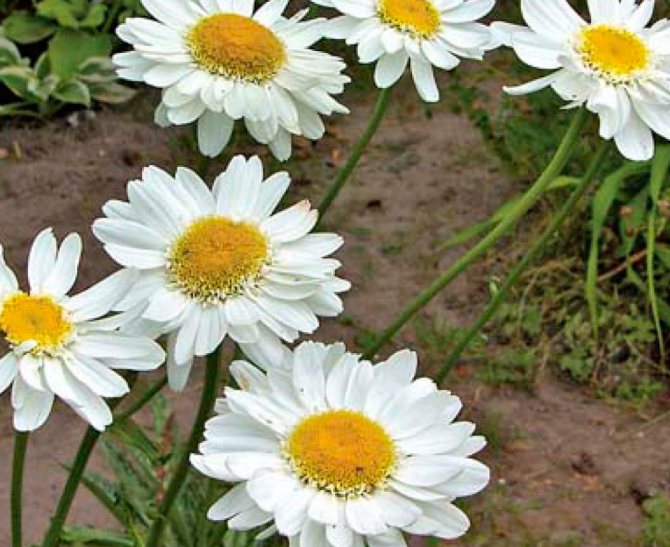

Used for group plantings, bouquets. Photo: The author of the plot tells how to use chamomile to protect against insects:
Using feverfew in the garden
Feverfew is often used to decorate curbs and paths. With the help of this flower, bright colorful flower beds are formed. A plant resembling a chamomile looks beautiful between garden trees and shrubs.
Feverfew is suitable for creating a wide variety of compositions and therefore is appreciated in landscape design. It is used to decorate balconies, terraces, verandas.
As you can see in the photo below, the cultivation of pyrethrum in the garden with other perennials is carried out quite successfully due to the fact that it is harmoniously combined with many ornamental crops.


Marigolds, marigolds, felicia, garden chamomile, bells, larkspur, cineraria and other flowers of yellow, orange, blue, orange and blue shades are wonderful neighbors for him. One has only to take into account that feverfew can grow successfully both in sunny and semi-shaded areas and select neighbors depending on their characteristics. For example, bells and cineraria prefer shade, while marigolds and marigolds grow well and develop in illuminated areas.
Since feverfew stands for a long time in the cut, it is often used to make bouquets.
Growing Dalmatian chamomile on the site
Before planting feverfew, the site is cultivated in a special way. This plant loves loose light soils. The site must be well lit. Stagnation of water in the ground is unacceptable. If the soil is too acidic, lime or ash should be added when digging.
When planting seeds, the similarity may not be good enough. For seedlings, it is better to use special containers. To prepare the nutrient mixture, mix equal proportions of garden soil, peat and humus. After sowing the seeds, the soil mixture must be well moistened. Then they should be covered with foil. The first shoots appear in a week. Saplings can be planted after they have 3 leaves. In this case, the air temperature must be at least + 20 ° C.
The first few weeks after planting, watering should be carried out 2 times every 7 days. In the future, irrigation can be performed once every 2 weeks. To eliminate the loss of water from the soil, its surface is mulched. Over the summer, you need to feed the mullein 2-3 times. After the end of flowering, mineral fertilizers are applied.
Description of the plant
Perennial culture effectively combines the simplicity of chamomile and the refined sophistication of chrysanthemum. Bright pyrethrum flowers can decorate any flower bed. Even inexperienced flower growers can grow plants, since crop care is simple.
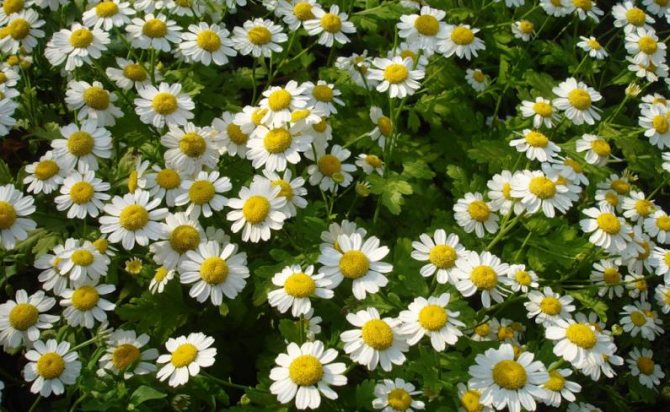

Perennial from the Asteraceae family
Feverfew is the most popular type with its chic white flowers. The bushes, depending on the variety of ornamental culture, can reach a height of 15-60 cm. Cirro-dissected leaf plates are painted in green tones. Inflorescences, resembling a basket in shape, are massively located on the upper parts of the shoots. Often inflorescences, tightly stuck to the tops of the shoots, form a kind of cap.
Site selection and soil
For Persian chamomile, choosing a place in the garden is quite simple. The main thing is that there is a slight elevation, otherwise precipitation will accumulate, because of which the plant may freeze out.
You cannot plant feverfew in sandy and poor soils. Otherwise, it can grow on any garden soil in partial shade or in bright light. In order for the plant to easily endure the summer heat, it needs to be watered in the evenings. Particular attention should be paid to this process during the flowering period, since the lack of water negatively affects the decorative effect.
Persian chamomile, if it grows in dense shade, loses its decorative effect. Her shoots begin to stretch out ugly, and the inflorescences thin and shrink.
The soil in which pyrethrum will be grown should be water and air permeable and have neutral acidity. A dense, moist soil containing a large amount of nutrients is not suitable for Persian chamomile. If this is the kind of soil in the garden, then it must be diluted with a lot of sand.
Where to buy seeds?
You can buy pyrethrum seeds in specialized flower shops, as well as order by mail or through an online store.
| Variety | Where can one buy | Price |
| Golden ball | Online store (delivery throughout Russia) | 15 rubles (0.05 g) |
| Troubadour (Zedek) | Hypermarket OBI | 20 rubles (0.2 g) |
| Robinson's Giants | Online store (delivery throughout Russia) | 21 rubles (0.2 g) |
Feverfew flower in the decoration of the garden area
Such a bush looks spectacular in the garden. It ideally complements mixborders, discounts. They can frame flower beds, as well as form group plantings, combining unique and spectacular color colors.
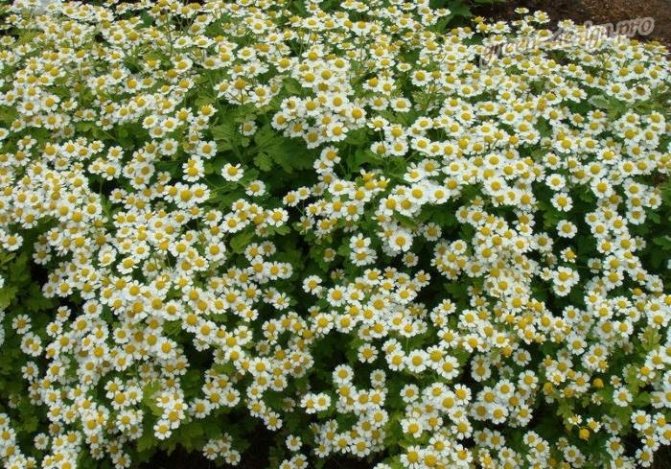

You can combine culture with chamomiles, bells, irises. Excellent planting partners are basil, swimsuit. Bushes planted next to ornamental trees or in alleys look beautiful.
The composition of flowers and the insecticidal activity of their components
Persian chamomile flowers contain pyrethrin, a resinous substance that is a mixture of esters of pyrethrolone and chrysanthemum acids. This mixture has a strong toxic effect on various arthropods - insects, spiders, ticks, millipedes, wood lice - but at the same time it is practically harmless to humans and warm-blooded animals, due to which it was previously actively used to combat cockroaches, bed bugs, lice, fleas and ticks.
Today, on the basis of natural pyrethrins extracted from chamomile inflorescences, synthetic pyrethroids are produced, which are much more effective than their predecessors. Due to this, pyrethrins and Persian chamomile itself have lost their importance for the national economy, although to some extent they continue to be used in folk medicine to combat head lice and scabies. Also, sometimes supporters of everything natural use powder from grated inflorescences of Persian chamomile to remove cockroaches and bedbugs from the house, although practice shows that such a struggle is rarely successful and does not allow all insects to be removed from the room.
Interestingly, Dalmatian chamomile is more often used as a raw material for obtaining an insecticide than Persian or Caucasian chamomile. This is due to the fact that the composition of its flowers contains the greatest amount of insecticidal components. At the same time, the effectiveness of the components of the Persian and Caucasian chamomiles is somewhat higher, therefore, in general, these species can be considered equivalent in their insecticidal activity.
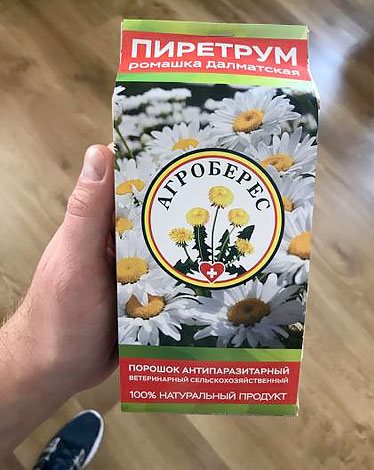

A typical preparation for the extermination of insects on the ground and in animal hair.
Also in the composition of the flowers of feverfew is the anti-inflammatory component parthenolide, known for its anti-inflammatory activity. Due to it, infusions are made from Persian chamomile and other plants of the Pyrethrum genus, which are used in folk medicine as an external anti-inflammatory and antirheumatic agent.
Watering and mulching
When the planted Persian chamomile is fully formed, it needs to be watered with a little water. The soil must be moistened in hot weather and in severe drought. If this is not done, feverfew will not die, but its flowers will become small, and the flowering period will be shortened. But the overflow is a great danger to the plant. The root system rots quickly in conditions of high humidity.
You need to mulch the flower at will. Since weeds do not grow next to an adult plant, and there is no need to retain moisture, mulch is used exclusively for decorative purposes.
Diseases
Feverfew is characterized by gray or brown rot. The plant can get sick from frequent watering, being in the shade or heavy soil. To grow Persian chamomile, you need to cut off the infected parts and treat it with a systemic fungicide.
Pests
Like any plant, Persian chamomile has its own ill-wishers. These include aphids and slugs, which feed on leaves and shoots. To destroy them, it is necessary to use folk remedies that will be safe for bees, so that they continue to pollinate the flowers.
Feverfew or Persian chamomile - as already mentioned, a useful and beautiful plant. Its cultivation does not require much effort. Gardeners pay great attention to the perennial varieties of this plant. The most widespread feverfew is maiden. The main rule for breeding feverfew is growing in the garden, but not at home. At home, the flower may die due to lack of fresh air and darkening. Chamomile can decorate a bouquet, and if it is collected from several varieties of this plant, especially with double flowers.
Now read:
- Varieties, planting and care of perennial rudbeckia
- Exquisite junkus (sitnik) spiral in the interior
- A persistent, large harvest of cucumbers after planting them for seedlings
- How to create hanging gardens in an apartment with indoor vines
About
Agronomist of the state agricultural enterprise "Garovskoye" of the Khabarovsk region of the Khabarovsk region.
Outdoor care
Feverfew requires very little attention, caring for it is not burdensome even for an inexperienced grower.
Watering
Due to the deep root system, the culture does not need frequent watering. It is worth watering it only during the flowering period, when it is hot outside. In moderate weather, there is no need for such a procedure. The flower tolerates drought well. After watering or after rain, loosen the soil near the bush to ensure free air penetration to the roots.
Top dressing and fertilization
In order for the inflorescences to form actively on the pyrethrum, in spring or autumn, during the digging of the site, it is recommended to bring rotted manure. From time to time, they can be fed to plants throughout the growing season. If the growth of the culture is slow or the flowering does not occur for a long time, you can fertilize the soil with complex mineral fertilizing.
Pruning
It is recommended to prune wilted inflorescences. This will allow the feverfew to retain the strength for re-flowering. Also, the removal of dry flowers is necessary in order to prevent self-seeding.There is no need to trim the stems during the growing season. They are removed before wintering.
Botanical status
Pyrethrum - Pyrethrum (P.), Chrysanthemum (Ch.) Or Tanacetum (T.) is a large group of herbaceous plants. For a long time, they were considered a genus of the numerous Aster family (Asteraceae). This genus included about a hundred different species. But more recently, they belong mainly to the genus Tansy. They are united by a common feature: inflorescences, consisting of white or pink petals in the form of tongues.
The overwhelming majority of species are perennials; annuals are less common. The homeland of pyrethrum is considered to be the warm regions of North America, Central Asia, Europe (Mediterranean, Caucasus). The Greek name for the plant is associated with one of its medicinal properties. The compound parthenolide contained in flowers and fruits helps to reduce high body temperature ("pyretos" - "heat").
The closest relatives of feverfew are asters and chamomile. It is no coincidence that its popular name is chamomile. But still, this is not a chamomile, but an independent genus. Sometimes he is also called the priest.
General form
The plant is a slender bush no higher than 1 m. It has ribbed, rather branched shoots, covered with a light down. Stems are both ascending and erect. The endurance and unpretentiousness of chamomile is largely due to the presence of a powerful root system. It is able to go deep into the ground up to 2.5-3 m.
Leaves
They are two-colored: grayish-green above and ashy below. The plates of the pyrethrum are located next. They consist of narrow segments. They keep on long lower petioles, which are significantly shortened at the tops of the stems.
Flowers
Inflorescences consist of bright baskets 50-60 mm in diameter. Their petals are pink, white or red, and the center is yellow. In one inflorescence there are male and female flowers. Bushes bloom in May-June, again - in August-September. Plants grow well in one place for 3-4 years, but then the inflorescences become smaller and smaller and lose their decorative effect.
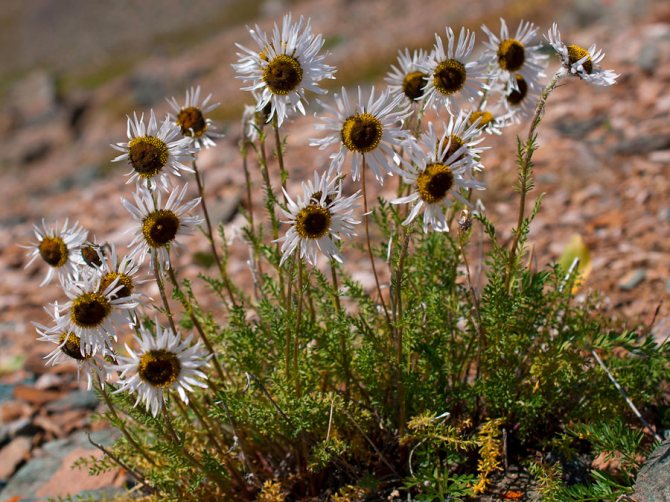

Fruit
It is a light brown or yellowish gray ribbed achene with a crown. Inside the fruit there are many small elongated seeds. Their germination capacity lasts 2-3 years.
WE PLANT YOURSELF!
Feverfew is undemanding to soil, but grows better on light loams and sandy loams. The main fertilizer for it is manure, which is brought in during the autumn digging. Chamomile prefers sunny places, in the shade and on very rich, fertile soils, it grows more green mass than blooms.
The seeds are sown directly into the ground in May. Seedlings must be thinned out, leaving a distance of 10-15 cm between them. Young plants can easily tolerate transplanting, so that the extra ones can be planted, including on vegetable beds.
The root secretions of pyrethrum scare off some pests: nematodes, onion flies, ticks, weevils. Feverfew reproduces well by self-seeding, and in areas with mild winters it can winter and grow as a perennial.
Gardeners reviews
Ludmila62
I also like pyrethrum, only red remains, for many years it has been growing in a compact bush, it does not grow. I like the annual abundant flowering and unpretentiousness.
Tatiana R
I, too, have been growing feverfew for many years, does not require special care.
Propagate by seed and dividing the bush
| Seeds
|
| By dividing the bush
|
Distribution and growth
In the wild, pyrethrum grows in mountainous areas. It is often found at 500-2000 m above sea level. This plant grows well on illuminated rocky, calcareous slopes. It is believed that the homeland of this plant is the southern regions of the Balkan Peninsula.
In the wild, it is also found in the mountainous areas of Altai, the Caucasus, southern Europe, Central Africa and Central Asia.
However, it has not been established whether pyrethrum is a representative of the local flora or the flowers were introduced to these regions. Human activities contributed to the spread of this plant. Now pyrethrum is actively cultivated in countries with mild climates, including:
- USA.
- Italy.
- Bulgaria.
- France.
- Japan.
- Georgia.
In addition, the cultivation of these flowers as perennials is carried out in the South of Russia and Ukraine, in Turkey and some other regions.


Care requirements
The plant requires a minimum of attention, which will delight busy growers. The area for feverfew should be lit and sunny. In partial shade, the bushes stretch out more.
Any soil composition is suitable, except for heavy and marshy ones. The composition of the acidic soil is improved by adding ash. The fertile land will provide large and vibrant flowers. There should be no stagnation of water in the area for feverfew.
Removing dry inflorescences will preserve decorativeness and prolong flowering, and there will not be self-seeding yet. In feverfew, you can get a second flowering, if all flower stalks are cut off immediately after the first. For higher grades, a garter is required.
Feverfew is not recommended to be kept in one place. The roots actively grow and intertwine, and the soil becomes impoverished over time. A transplant is needed every 3-4 years with the simultaneous division of the bush.
The flower is cold-hardy and winters well in the soil. With the onset of cold weather, the stems are cut off, and the bush is covered with peat, dry leaves, spruce branches.


Watering and feeding
Pyrethrum is drought-resistant. They need watering only on hot days. Otherwise, the leaves lose their turgor, and the earth cracks. Moisture is important for flowers even at the time of flowering.
New plantings are immediately mulched with peat or cut grass. Mulch protects against moisture loss, crusting and annoying weeds.
Fertilizer is applied 2-3 times a season. Adding mullein is beneficial for flowering and growth. The first feeding is done in the spring, before the buds bloom. When flowering is over, fertilize with a complex fertilizer. In late summer and early autumn, the bushes are watered with herbal infusion.







